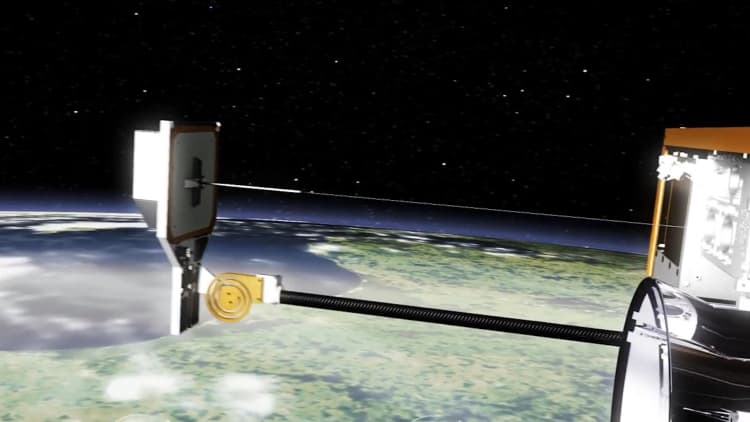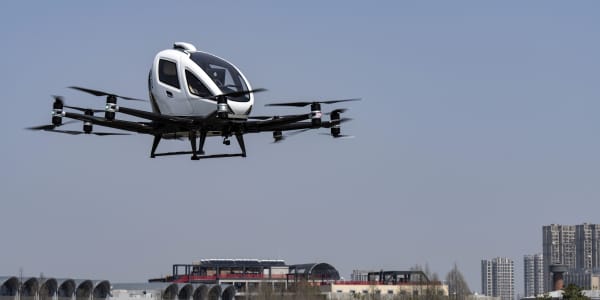President Donald Trump signed the third space directive of his presidency Monday, urging the Defense Department and Commerce Department to step up the United States' ability to track objects in space and protect against the increasing threat from debris in orbit around the Earth.
The U.S. military is already tracking more than 23,000 objects in space around the Earth and several companies are planning to add thousands more satellites to orbit over the next few years. According to AGI, a company which provides software to commercial and government entities to analyze and track objects, the current public catalogs "only account for about 4 percent of the objects in space around the Earth," AGI Vice President Travis Langster told CNBC in March.
The directive takes another step toward fulfilling the vision laid out in April by Vice President Mike Pence and Commerce Secretary Wilbur Ross, who both spoke of streamlining federal space regulations and putting more resources toward reducing the danger from objects in space. Pence said in April that the National Space Council was sending "the first comprehensive space traffic management policy" for Trump to sign.
"This new policy directs the Department of Commerce to provide a basic level of space situational awareness, for public and private use, based on the space catalog compiled by the Department of Defense," Pence said in April.
The White House wants the U.S. to use all available public and private resources to combat the issue of space junk, including that the Commerce Department "will make space safety data and services" available to the public. The Pentagon will continue to maintain its current catalog of objects – data it sells to satellite operators.
Trump's directive on Monday also requires an unspecified entity update the U.S. Orbital Debris Mitigation Standard Practices and the creation of new guidelines for satellite design and operation. There are no time frames to implementation for any of the guidelines or requirements in the directive.
Catalyzed by incidents in the late 2000s, both commercial and military entities are working to solve the growing space debris problem. Moving at thousands of miles per hour in orbit, objects 2 centimeters or larger are capable of causing catastrophic damage to anything that gets in the way. Today's technology can track objects in space about the size of 10 centimeters, according to AGI.
Lockheed Martin is nearly complete with a system called Space Fence for the U.S. Air Force, which could improve the Air Force's catalog of objects in space "ten-fold from what it is today," program director Bruce Schafhauser told CNBC.
SpaceX is testing the first satellites of what will become a constellation of more than 4,425 satellites, which the FCC approved in March. Satellite operators Telesat, Boeing, OneWeb, EarthNow and more have raised billions of dollars towards building constellations, each involving hundreds of satellites in various orbits.
"Space is becoming an increasingly congested environment … particularly now with SpaceX, One Web and Boeing, among others, putting constellations up," Schafhauser said.
Space Fence "looks like a wedge-shaped fan of energy," says Schafhauser, and is expected to go online in 2019. Today's technology can track objects in space about 10 centimeters wide but Space Fence is sensitive enough to track "marble-sized objects in low Earth orbit," Schafhauser said.
With near-misses becoming increasingly common, companies focused on space debris now make up 2 percent of the $350 billion space industry. The Commerce Department continues to pursue the means of policing debris in space, according to Ross, as well as finding a solution for all the junk that is already in orbit.
"As more and more launches occur, more and more satellites reach the end of their life, that's going to be a problem we have to deal with," Ross said in April.
Read the full Space Policy Directive - 3 here:
President Donald J. Trump signed Space Policy Directive – 3 directing the United States to lead the management of traffic and mitigate the effects of debris in space.
Space Policy Directive – 3 provides guidelines and direction to ensure that the United States is a leader in providing a safe and secure environment as commercial and civil space traffic increases.
As space becomes increasingly contested, the demand for the Department of Defense to focus on protecting U.S. space assets and interests also increases.
At the same time, the rapid commercialization of space requires a traffic management framework that protects U.S. interests and considers the private sector's needs.
The new Directive seeks to reduce the growing threat of orbital debris to the common interest of all nations.
The Directive articulates the policy of the United States to pursue and utilize both Government and commercial sector technologies to track and monitor space debris.
The Directive requires updates to the U.S. Orbital Debris Mitigation Standard Practices and new guidelines for satellite design and operation.
The new Directive sets guidelines for the United States to manage space traffic more effectively by spearheading new data sharing initiatives.
The United States should continue to provide basic space situational awareness data and basic space traffic management services free of direct user fees.
The Department of Commerce will make space safety data and services available to the public, while the Department of Defense maintains the authoritative catalogue of space objects.
The United States will maintain and expand its leadership in space by increasing its capabilities and developing standards and best practices. This effort will:
Improve space situational awareness data standards and information sharing;
Leverage U.S. standards and best practices to shape international norms; and
Streamline processes and reduce regulatory burdens that inhibit commercial growth, enabling the U.S. commercial sector to lead the world in space.
Watch: This harpoon could capture the potentially hazardous debris orbiting the Earth







